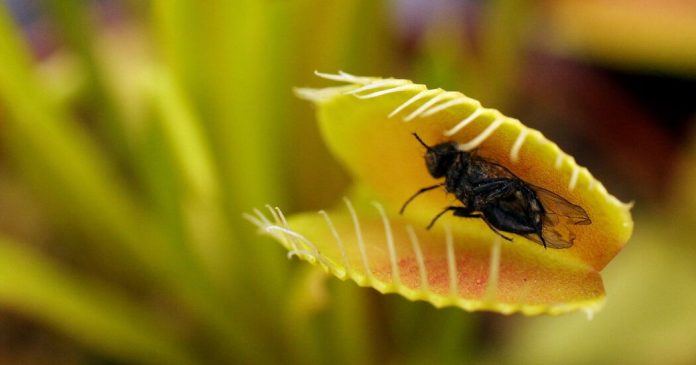The carnivorous plant Venus flytrap (Dionaea muscipula) captures and digests small animals and absorbs nutrients with its characteristic insectivorous leaves. Six sensory hairs on the inner surface of each leaf sense a visiting prey and cause the trap to close. A single contact event with a sensory hair is not sufficient, but a second contact within 30 seconds will induce the trap to close quickly and ensnare the unlucky prey. Thus, Venus flytraps store the memory of the first stimulus for about 30 seconds. But how does a plant memorize anything when it has no brain or nervous system?
In 1988, Dr. Dieter Hodick and Dr. Andreas Sievers from the Botanical Institute at the University of Bonn, Germany speculated that changes in calcium ions might be involved in the memory of the Venus flytrap. However, lacking the technological means to measure calcium concentrations without damaging the cells, they were unable to explore this possibility.
Now, in a study to be published in Nature Plants, a graduate student Mr. Hiraku Suda and Professor Mitsuyasu Hasebe of the National Institute for Basic Biology (NIBB) in Okazaki, Japan, together with their colleagues, have succeeded in visualizing intracellular calcium concentrations in the Venus flytrap and have demonstrated that its short-term memory can indeed be explained by changes in calcium concentration.
The research team first established a genetic transformation method for the Venus flytrap. They then introduced the gene encoding the intracellular calcium sensor protein GCaMP6, which emits green fluorescence when bound to calcium, into the insectivorous plant, allowing them to visualize changes in intracellular calcium concentrations for the first time.
Mr. Hiraku Suda, the first author of the article says, “I tried so many experiments over two and a half years but all failed. The Venus flytrap was such an attractive system that I did not give up. I finally noticed that foreign DNA integrated with high efficiency into the Venus flytrap grown in the dark. It was a small but indispensable clue.”
Using these transgenic Venus flytrap plants, the research team stimulated a single sensory hair with a needle and measured the changes in calcium levels within the leaf in detail.
Whereas the first stimulation increased the intracellular calcium concentration in the leaf blade, the second stimulus further raised the calcium ion concentration. These results revealed that the trap only closes when the intracellular calcium concentration exceeds a certain threshold.





























